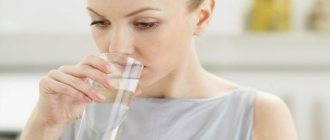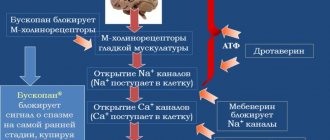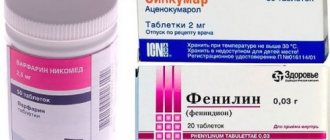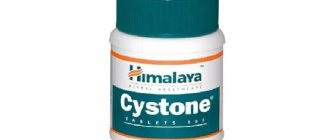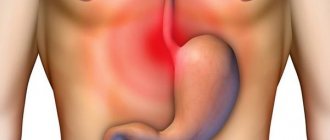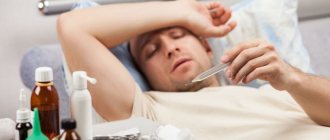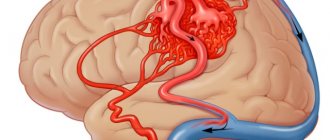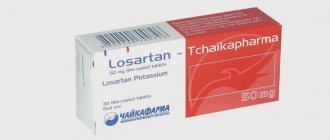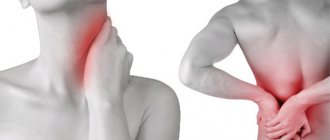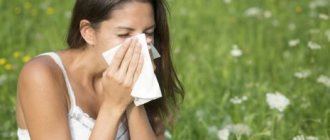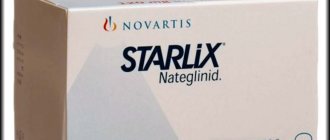What are cholekinetics?
Thanks to drugs in this category, it is possible to prevent the possible development of pathologies associated with the functioning of the gallbladder and liver. Cholekinetics are prescribed for atony of the gallbladder, cholecystitis (at the chronic stage), and hepatitis.
Also, drugs in this category help improve the condition of dyskinesia (involuntary movements) of the biliary tract, gastritis (provided there is low or no acidity), as well as in preparation for the probing procedure.
They are antispasmodic drugs that promote the secretion of bile. They are also responsible for regulating cholecystokinin (a gut hormone).
There are 2 groups of cholekinetics:
- Cholekinetics. These include magnesium sulfate, various bitter plants, sour berry juice, polyhydric alcohols (for example, sorbitol).
- Cholespasmolytics. This subgroup includes hyoscine butyl bromide, trotaverine and papaverine.
Cholekinetics are prescribed for:
- antonia of the gallbladder (with an additional diagnosis of bile stagnation);
- gallbladder dyskinesia;
- chronic stage of cholecystitis;
- performing a duodenal intubation procedure;
- chronic stage of hepatitis;
- anacid or hypoacid gastritis.
Cholespasmolytics help with gallstone disease. They are also used to relieve pain, which often occurs due to pathologies of the biliary tract.
Classification
Medications
- Choleretics are drugs that help increase bile production. They can be made from both natural and synthetic components. Separately, it is worth noting hydrocholeretics, which increase the volume of bile by diluting it with water. Among the choleretics one can distinguish “Allohol”, “Holosas” and “Digestal”.
- Cholekinetics - these drugs are aimed at normalizing the outflow of bile into the duodenum. These include Olimethine and Atropine.
- Cholespasmolytics - relax the muscles of the gallbladder, promote the outflow of bile and relieve severe pain that can occur against the background of certain diseases. Popular cholespasmolytics are Drotaverine, Papaverine, No-Shpa, Metacin and Besalol.
- Drugs to reduce the bile lithogenicity index - these drugs are aimed at preventing the formation of stones, as well as dissolving existing stones. Examples include medications such as Livodexa and Urso 1002. One of the best drugs in this group, recommended for a removed bladder, is Ursofalk.
- Herbal preparations are considered the safest. Their main components are extracts of medicinal plants. The list of natural choleretic agents includes Datiscan, Tanaflon and Urolesan.
Folk remedies
Among folk remedies, extracts and juices of medicinal plants and herbs occupy a special place. The following have an excellent choleretic effect:
- wolfberry bark;
- rhizomes of Tatarian grass;
- cinnamon leaves;
- mint;
- red grass;
- burdock roots;
- olive oil;
- field chamomile flowers;
- immortelle;
- Birch buds;
- rowan fruits;
- common knotweed, etc.
Mechanism of action
These are drugs that are responsible for increasing the volume of bile entering the duodenum. However, the effect of this type of remedy is different from others. For example, choleric people have an effect on liver cells, due to which it begins to synthesize secretions with increased intensity.
Cholekinetics have an effect on the gallbladder, that is, they are responsible for the production of so-called mature bile. Thanks to these drugs, the gallbladder muscles begin to contract more intensely.
At the same time, the effect is on the sphincters (valves) in the bile ducts. They relax and expand. Freer bile ducts make it easier for bile to enter the duodenum.
Based on the mechanism of action on the body, it is worth noting some features of drugs in this category, depending on the patient’s condition.
| Patient's diagnosis or condition | Features of choosing funds |
| Pregnancy | Since the drug has an antispasmodic effect, it is important that the drug does not cause uterine contractions. |
| Stagnation of bile | It is recommended to choose cholekinetics, as they further improve the condition of the digestive system. |
| Cholecystitis | It is worth giving preference to drugs that additionally promote the dissolution of gallstones. |
| Bend of the gallbladder | Treatment can be carried out using cholekinetics or cholespasmolytics. Additionally, bile acid preparations are prescribed. |
Choleretic drugs
In most cases, for biliary stagnation and biliary dyskinesia, the following drugs are prescribed:
- Choleretics – are responsible for increasing the concentration of bile acids in bile;
- Cholekinetics – enhance bile outflow by improving bladder tone;
- Cholespasmolytics – have a relaxing effect on the gallbladder and bile ducts.
Choleretics
The properties of choleretics include improving liver functionality and improving the outflow of synthesized bile. This type of medicine is divided into true, synthetic, herbal and hydrocholeretics.
True choleretics are made from herbal extracts, bovine bile secretions and animal enzymes. The most commonly prescribed drugs of this type are Allohol, Hologon, Cholenzym, Decholin and Liobil.
Synthetic choleretics (Osalmid, Odeston, Nicodin and Tsikvalon) copy the effect of natural drugs, but they contain chemically created substances. Their advantages include choleretic, anti-inflammatory, antibacterial and antispasmodic effects.
Choleretic agents of plant origin reduce the viscosity of bile secretions, improve its outflow and normalize liver functionality. This category includes many different drugs, but the most popular of them are Holosas, Flamin, Urolesan, Chofitol and Berberis.
Hydrocholeretics dilute bile with water, resulting in an increase in its volume.
The classification of choleretics is presented in the table:
| True choleretics | Allohol | It contains dry bile, activated carbon, nettle and garlic extracts. The main properties of the drug: enhancing the synthesis of secretions and suppressing putrefactive processes. |
| Holagol | Consists of eucalyptus and mint oils, turmeric root, magnesium salicylate and olive oil. It has choleretic and antispasmodic properties. | |
| Holenzym | The main ingredients of the drug include dry bile, the mucous surface of the intestines of cattle, dry pancreas and digestive enzymes. | |
| Synthetic choleretics | Odeston | Its components include hymecromone, which has an antispasmodic and choleretic effect. It has a relaxing effect on the bile ducts and sphincter of Oddi, thereby reducing bile stagnation and preventing the accumulation of stones. |
| Nikodin | Contains synthetic organic acid. The main property is antimicrobial. | |
| Cyqualon | It has anti-inflammatory and choleretic properties. | |
| Plant choleretics | Berberine | It contains extract of barberry leaves and roots. Cannot be used during pregnancy. |
| Tanacehol | The main component is tansy flower extract. The drug can increase the volume of bile secreted and change its chemical composition. | |
| Flamin | Contains immortelle flavonoids. The main properties of the drug are considered to be an increase in the production of bile secretions and its dilution, as well as the destruction of bacteria and improved digestion of food. | |
| Holosas | Its main properties are the restoration of bile outflow, a diuretic and anti-inflammatory effect, strengthening the immune system and improving intestinal motility. The main active ingredient is rosehip extract. | |
| Hydrocholeretics (bile-thinning drugs) | Valerian preparations | They have a slight antispasmodic and choleretic effect. It has a positive effect on the condition of the gastrointestinal mucosa. |
| Salicylates | They dilute the synthesized bile, thereby increasing its volume. This group of drugs includes ibuprofen, phenylbutazone, indomethacin, etc. |
Cholekinetics
Cholekinetics are drugs that have an antispasmodic effect and accelerate the release of bile acid. They restore the tone of the bladder, normalize its contraction and relax the bile ducts.
The most popular means of this group include:
- Papaverine - reduces the tone of smooth muscle fibers and has a beneficial effect on blood circulation in many internal organs.
- Drotaverine - the properties of this medicine are similar to the action of Papaverine, but it is considered the most effective. In addition, it is able to stop spastic processes.
- Platiphylline – improves the tone of the gallbladder. Most often prescribed for dyskinesia.
- Xylitol, Sorbitol and other sugar substitutes accelerate the excretion of bile.
- Magnesium sulfate (Cormagnesin) is a natural substance that can eliminate excess calcium. It also has a relaxing effect on muscles.
- Products with rose hips – Holemaks, Holosas, etc.
Cholespasmolytics
Drugs in this group reduce the tone of the bile ducts, relieve spasms and eliminate pain. They come in both chemical and plant origin.
- Atropine is a drug that reduces the muscle tone of internal organs and blocks cholinergic receptors, as well as reducing the motor function of the digestive canal. At the same time, it has virtually no effect on bile synthesis.
- Besalol is a combination product that contains phenyl salicylate and belladonna extract. Able to block bacterial growth and eliminate spasms.
- Duspatalin - one of the main active ingredients of the drug is mebeverine (a strong antispasmodic), which ensures the elimination of discomfort in the digestive canal.
- Kholagol and other natural preparations and herbal tinctures that have an antispasmodic effect. They most often include St. John's wort, arnica, calendula, elecampane, lemon balm, mint, etc.
General application information
Cholekinetics are drugs, the list of which will be discussed below, that cause adverse reactions. For example, taking such drugs may cause nausea, vomiting, and polyuria (increased urine production). Also, cholekinetics can often provoke an exacerbation of an existing intestinal disease.
They are contraindicated if a person suffers from an acute stage of liver pathology. Also, you should not take drugs from this group during exacerbation of gastritis and gastric ulcers. In such a situation, cholekinetics and cholespasmolytics can only aggravate the situation and will not be of any benefit.
Therefore, these medications can only be taken after visiting a specialist (gastroenterologist) and undergoing an examination.
If there are no contraindications, then timely use of cholekinetics will avoid infection and inflammatory processes.
Odeston
This medicine affects the functioning of the system that removes bile and the liver - it increases the volume of bile secretion, facilitates its removal and relieves muscle spasms in the tract. The tablets prevent cholestasis from developing and cope well with bile stagnation. Hypercromone is the active substance in its composition.
The drug removes spasms of the sphincter of Oddi and smooth muscle muscles, which frees up the path along which bile can move without problems. At the same time, no effect on the muscles of the organ itself was detected, which distinguishes this remedy from medications that have a herbal component.
A couple of hours after use, Odeston penetrates the gastrointestinal tract, reaching higher concentrations in the blood. Despite all its advantages, there are clear contraindications:
- developing foci of ulcers in the stomach;
- Crohn's disease;
- duodenal ulcer;
- hemophilia;
- severe liver or kidney damage.
Morphine should not be taken with this medicine because it leads to sphincter spasms, which reduces the therapeutic effect of Odeston.
Forms of cholekinetics, list of the best drugs
If we talk about the most popular drugs in this group, then it is worth highlighting several funds. Cholekinetics can be produced in the form of tablets, solutions for subcutaneous administration, suppositories and powders for the preparation of solutions.
Platyfillin
The drug has a beneficial effect on the heart, improves myocardial excitability, and dilates small vessels of the skin. This drug is well absorbed from the gastrointestinal tract. During hydrolysis it forms platinecin and platinecinic acid. The drug costs about 75-90 rubles.
The drug is prescribed for:
- cholecystitis;
- stomach ulcers;
- intestinal colic;
- renal colic;
- pylorospasm.
It is also prescribed for many pathologies of the cardiovascular system. Platiphylline is sold in the form of tablets and suppositories for rectal administration.
The exact form and dosage is determined by the doctor. The drug has no contraindications. Only if the patient has an individual intolerance to platyphylline should he refrain from taking it.
Also, pregnant women should not purchase this drug. Studies of the effect on the body of a woman carrying a child have not been conducted. You should take the drug with caution in case of renal failure and impaired renal function. You should also be very careful when giving Platyphylline to children, especially those who suffer from lung diseases.
Papaverine
Cholekinetics are drugs, the list of which is extensive. They are not always recommended for children. But Papaverine is one of the few drugs that is prescribed to children over the age of six months.
As a rule, it is prescribed when spasms of smooth muscles of organs in the abdominal cavity occur.
It also helps alleviate the condition of the blood vessels of the brain and bronchi.
In addition, Papaverine is prescribed if the patient is prescribed combination therapy. When taken orally, the drug is prescribed at a dose of 40-60 mg up to 5 times a day. If we are talking about rectal suppositories, then they are given 2-3 times a day, 20-40 mg. The doctor may also prescribe 10-20 mg suppositories, provided that the drug is administered every 4 hours. Children over the age of 1 year can take no more than 300 mcg/kg. For younger patients, the dosage is prescribed individually. The cost of Papaverine is from 20 rubles. If we talk about contraindications, the drug should not be taken for glaucoma, AV block (partial or complete disruption of the conduction of impulses from the atrium to the ventricles), liver failure, hyperthermia.
It has not been established how safe Papaverine is for pregnant women, so they should also avoid taking this drug. It is also not prescribed for the diagnosis of severe renal failure.
Magnesium sulfate
This is one of the most common choleretic drugs. Additionally, Magnesium sulfate has a laxative effect. The product costs from 15 rubles.
The drug is prescribed for constipation, cholangitis, cholecystitis, gallbladder dyskinesia. The drug is also prescribed for arterial hypertension, polymorphic ventricular tachycardia, encephalopathy, and heavy metal poisoning (for example, mercury or arsenic).
There is no general dosage for this product. It is prescribed exclusively on an individual basis. Among the side effects of the drug, it is worth noting the possibility of nausea, diarrhea, exacerbation of inflammatory pathologies of the gastrointestinal tract, and electrolyte imbalance. The drug should not be taken in the chronic stage of renal failure or high sensitivity to the substance.
During pregnancy, this drug can be taken. However, everything depends on the condition of the fetus. If there is even the slightest risk, then you should avoid this substance. But in case of chronic renal failure, the drug is contraindicated.
Atropine
This is another drug that a gastroenterologist may prescribe. Atropine is prescribed for gastric ulcers, acute pancreatitis, and colic. It is also prescribed before surgery. The product is sold in the form of eye drops and injection solutions. The dosage is prescribed by the attending physician.
Among the side effects of the drug, it is worth highlighting the appearance of dry mouth, constipation, and tachycardia. However, such symptoms appear only under the condition of systemic use of Atropine.
The drug is contraindicated for people suffering from hypersensitivity to the main component of the drug. Pregnant women should also avoid taking Atropine. It is able to pass through the placental barrier. No other studies have yet been conducted. If the drug was administered intravenously, it may cause tachycardia in the fetus (if labor is due very soon).
Atropine is allowed for the treatment of liver failure. However, if any side effects occur, this drug should be discontinued immediately. The same applies to patients diagnosed with kidney failure.
Atropine can be given to children. However, you need to be careful if your child has lung disease or has recently suffered brain damage.
Elderly patients should exercise caution in case of cardiovascular diseases.
Sorbitol
This is a popular sugar substitute that is also a good stimulator of bile formation. Sorbitol also has a laxative effect. Therefore, it is usually prescribed for constipation, biliary dysfunction, and poisoning.
The dosage of the drug depends on the specific situation. For example, for constipation, you need to dissolve several packets of sorbitol in half a glass of warm water and take it before bed. Children are prescribed twice as much.
For a faster effect, the solution is administered using an enema. In this case, you will need to dilute 10 sachets of sorbitol in 200 ml of water. In case of poisoning, sorbitol should be diluted at the rate of 1 g per kg of human body weight.
Sorbitol is contraindicated in case of hypersensitivity to it or bile duct obstruction. It is also not recommended to take it in case of pathologies of the liver and kidneys.
In addition, sorbitol may have a negative effect on those who are fructose intolerant, suffer from colitis or irritable bowel syndrome.
During pregnancy, taking sorbitol is allowed, but only after consultation.
Cholekinetics are drugs, the list of which may include natural remedies that cope with their main function just as well.
Amino acid derivatives
Amino acid derivatives are also often used for diseases of the hepatobiliary system. They have a strong evidence base. According to hepatologists, amino acids are an order of magnitude more effective than essential phospholipids.
Hepatoprotectors include either ademetionine or ornithine aspartate. Ademetionine is an amino acid that takes part in the synthesis of phospholipids and bioactive substances. It has antioxidant, anti-inflammatory, hepatoprotective effects.
Ornithine is an amino acid that reduces the level of ammonia in the blood, normalizes the functionality of the liver and brain, cleanses the body of toxins, helps stop inflammatory processes in the liver and gallbladder, and prevents the development of fibrosis.
Best amino acids:
- Based on ademetionine - Heptral and Heptor. They are produced in the form of tablets and lyophilisate, from which a solution is prepared for infusion (via a dropper). Heptral and Heptor are prescribed to persons who have been diagnosed with chronic hepatitis of any origin, fatty hepatosis, intoxication, chronic non-calculous cholecystitis, liver cirrhosis, liver failure, hepatic encephalopathy. Ademetionine also helps cope with depression and intrahepatic cholestasis in pregnant women.
- Based on ornithine - Hepa-Merz and Ornithine Canon. They are used for the treatment of acute and chronic diseases of the hepatobiliary system, which are accompanied by hyperammonemia. The list of indications also includes steatosis, steatohepatitis and hepatic encephalopathy.
With stagnation of bile
In this case, preference should be given to drugs that prevent stagnation of bile deposits. Most often, such products contain ursodeoxycholic acid or its analogues.
This substance improves the removal of cholesterol from bile secretions. Also, drugs based on ursodeoxycholic acid accelerate the process of dissolving stones and prevent the formation of new deposits.
In case of bile stagnation (the pathology is called cholestasis), the cholekinetic agents Holosas, Flamin and Berberine are most often prescribed. Choleretics also help well. These include Odeston, Holenzim and others.
If there are no stones in the gall bladder or their size does not exceed 3 mm, then taking bile acids is also allowed. If, in addition to stagnation of bile, yellowing and itching of the skin is observed, then in addition to choleretic drugs, additional medications may be prescribed, and treatment is most often carried out in a hospital setting.
Cholespasmolytics
The group's medications are aimed at reducing tone and spasms in the gallbladder and bile ducts. The drugs facilitate the excretion of bile into the intestines and are indicated for stagnation of secretions. They are prescribed for immediate help with cholelithiasis, hepatic colic, cholangitis, cholestasis, cirrhosis, painful spasms against the background of tumor growth.
Medicines are divided into:
- herbal - contain extracts of mint, St. John's wort, lemon balm, calendula, arnica, elecampane;
- artificial – synthetically bred, containing papaverine, aminophylline, drotaverine;
- anticholinergics - block or weaken the effects of acetylcholine, contain atropine, besalol.
| Name | Active substance | Mode of application | Side effects | Contraindications | Price, rubles |
| Holagol | Turmeric pigments, frangulaemodin, magnesium salicylate, peppermint and eucalyptus oils. | 5-10 drops on a piece of sugar three times a day. | Bronchospasm, belching, diarrhea. | Biliary tract obstruction, active ulcer, hemorrhagic diathesis, age up to 16 years. | 200 for 10 ml |
| Duspatalin | Mebeverine | 20 minutes before meals, 200 mg twice daily. | Urticaria, exanthema. | Age up to 18 years. | 675 for 50 tablets |
| Spasmolitin | Adiphenine | After meals, 50-100 mg 3-4 times a day for a course of 3-4 weeks. | Nausea, vomiting, heartburn, allergies. | Angle-closure glaucoma. | 60 for 10 pcs. |
When the gallbladder is bent
If the patient is diagnosed with this, then this most likely means the presence of biliary dyskinesia. It is usually hypokinetic, that is, when bile must overcome many more obstacles on its way to the gallbladder. In this case, cholekinetics and cholespasmolytics are used.
When the gallbladder is bent, Flamin, Urolesan, Allohol and Odeston are prescribed.
Causes and symptoms of cholestasis
The functioning of the gallbladder is influenced by many factors. The causes of cholestasis are:
- Increased nervousness – muscles spasm due to stress.
- Instability of the emotional background slows down the digestive function.
- Consumption of food rich in cholesterol - bile simply cannot cope with its processing.
- Unbalanced nutrition - the liver is loaded.
- Low motor activity – tissue hypoxia occurs.
- Taking certain medications worsens the activity of bile outflow.
- Weak abdominal muscles - the gallbladder is not in its place.
- Inflection of the gallbladder - can be congenital or acquired due to kidney disease, liver disease, muscle hypermobility, poor diet, severe physical activity, obesity, alcohol abuse, organ prolapse. The condition is characterized by a decrease in the synthesis and deterioration of bile excretion, and threatens the development of stones and polyps.
You can suspect a violation of biliary function based on specific symptoms:
- constipation, diarrhea;
- loss of appetite;
- vomiting, nausea, heartburn, belching air, bitterness in the mouth;
- dull pain in the right side, radiating to the collarbone, spine, neck;
- bloating and heaviness after eating;
- increased sweating;
- bad breath;
- yellowing of the skin and sclera;
- skin itching;
- dark urine, light feces.
For pregnant
When carrying a child, you need to choose medications with extreme caution. If you start taking medications that help increase uterine contractility, there is a risk of miscarriage and premature contractions.
The safest drugs in this case will be No-Shpa, Holosas, Papaverine, Atropine and Drotaverine. Odeston, Flamin and Cholestil are allowed to be taken exclusively under the supervision of the attending physician.
Pregnant women should not give preference to medicinal herbs, believing that they have a more gentle effect. As a rule, such medications contain a large amount of active substances, which can harm the fetus.
Conservative methods of treating chronic cholecystitis
Treatment of chronic cholecystitis is usually carried out with conservative methods (but surgery may also be required).
Among its main goals:
- elimination of inflammatory changes in the wall of the gallbladder;
- prevention of complications;
- elimination of symptoms of pathology;
- improving the quality of life and rehabilitation of patients.
It is important to reduce the number of exacerbations
Important! The treatment plan is drawn up by the doctor individually for each patient. The chosen tactics are largely determined by the clinical course of the pathology (frequency and severity of exacerbations), the presence/absence of stones, and the functional state of the gallbladder.
Non-drug therapy
Before we look at what medications to take for cholecystitis, we would like to draw your attention to the fact that diet therapy remains an important method of treatment. All patients with XX should adhere to treatment table No. 5 (according to Pevzner).
Among its principles:
- Frequent and, importantly, small meals (about 5-6 times a day).
- Creating and maintaining a clear diet.
- Consume 2500-2900 kcal per day.
- Creating a menu with the optimal content of proteins, fats and carbohydrates.
- Reducing the proportion of animal fats in the diet and increasing the proportion of plant fats.
- Drink plenty of fluids (about 2 liters of clean water per day).
- The preferred heat treatment options are boiling and steaming.
We treat the body from the inside
Among the permitted products:
- lean meat (poultry, rabbit, beef, fish);
- wheat bran;
- cereals (especially millet, buckwheat);
- fermented milk products;
- vegetables and fruits.
In addition to water, it is useful to drink dried fruit compotes and rosehip decoction.
The following are excluded from the diet of patients:
- fatty, smoked dishes;
- fatty meat and offal (kidneys, brains, tongue, etc.);
- egg yolks;
- spices and seasonings;
- rich broths;
- baked goods and confectionery products;
- nuts;
- alcohol;
- carbonated drinks.
Permitted and prohibited products
Important! Patients with chronic disease are recommended to adhere to a therapeutic diet throughout their lives. This will help significantly reduce the number of exacerbations.
Drug therapy
Medicines for cholecystitis of the gallbladder are another mandatory element of therapy. It is very important that all tablets and injections are prescribed by a qualified doctor (generalist or gastroenterologist) based on the examination data obtained. Only a specialist will be able to assess the nuances of the pathology and the individual characteristics of the body.
What medications will be helpful for you?
So, what to take for cholecystitis: medications are divided into several pharmacological groups.
Table: Injections and tablets for cholecystitis of the gallbladder:
| Group | Mechanism of action | Representatives |
| Antibiotics | Elimination of bacterial infections and local inflammation | Azithromycin, Ampicillin, Amoxicillin, Ceftriaxone, Metronidazole |
| Sulfonamides | Destruction of pathogenic microorganisms in the intestines (with concomitant inflammation) | Sulfadimezin, Sulfalene |
| Antimycotics | Destruction of fungi that can rapidly multiply in the gastrointestinal tract in response to antimicrobial therapy | Nystatin, Fluconazole, Furazolidone |
| Choleretic drugs | Normalization of bile production and outflow | Allohol, Holosas, Chofitol |
| Antispasmodics | Relieving muscle spasms, eliminating pain syndrome | No-shpa, Papaverine, Trimedat, Duspatalin |
| Hepatoprotectors | Restoration of liver function, acceleration of hepatocyte regeneration | Essliver, Essentiale forte, Ursosan, Karsil, Heptral |
Antibiotics, sulfonamides and antifungals
Antibiotics for cholecystitis and liver inflammation are an important component of treatment. However, before choosing one or another drug, it is important to undergo a detailed diagnostic study, identify the causative agent of inflammation and determine its sensitivity to antimicrobial agents.
An antibiotic for cholecystitis must have specific activity against microbes colonizing on the walls of the gallbladder.
There are so many medications - which one will help?
Most often, patients are prescribed cephalosporins. They are the ones who effectively defeat cholecystitis: antibiotics have high activity and a wide spectrum of action. In case of severe exacerbation of the disease, drugs of the erythromycin group are recommended.
What tablets should pregnant women, elderly patients and children take for cholecystitis? For them, effective and absolutely safe antibiotics of the penicillin group would be an excellent option. Due to the fact that they accumulate well in bile, the therapeutic effect occurs quite quickly.
Comparative price chart for antimicrobials
Note! Any medicine for cholecystitis of the gallbladder has its contraindications. Follow the recommendations of your healthcare professional and read the instructions for use carefully.
On average, the course of antibiotic therapy for exacerbation of chronic disease is 10-14 days. If the drug is chosen correctly, already on the 2-3rd day of treatment the patient feels much better.
Sulfonamides are a replacement for antibiotics. They are prescribed for:
- the impossibility of antimicrobial therapy with “classical” agents;
- complication of chronic inflammation of the intestinal mucosa.
Antimycotics are indicated for the activation of pathogenic fungal flora in the body. This phenomenon often occurs against the background of antimicrobial therapy, so some experts consider their preventive (prophylactic) use advisable.
Fungal infection is a common complication of antibiotic therapy
Choleretic drugs
Choleretic drugs for cholecystitis are an essential component of treatment.
According to their pharmacological action, they can be divided into two large groups:
- Choleretics – drugs that enhance bile production;
- Cholekinetics are medications that help normalize the flow of bile.
Choleretics include:
- products based on ox bile - Cholenzym, Allochol;
- plant sterols – corn silk, immortelle flowers, rose hip extract;
- synthetic drugs - Nicodin, Osalmid, Cyclovalon.
Plant-based products are effective and inexpensive
Cholekinetics are another frequently prescribed drug for cholecystitis: stagnation of bile when taken is eliminated by increasing the tone of the muscles of the bile ducts and gallbladder and enhancing its contractions.
Important! Choleretic drugs are contraindicated for obstructive jaundice, acute hepatitis, and concomitant decompensated gastrointestinal diseases. How to take Allohol for cholecystitis accompanied by gallstones, check with your doctor.
Antispasmodic drugs
“How to relieve pain with cholecystitis?” - perhaps one of the most frequently asked questions from patients. Antispasmodics can help with this - a group of medications that eliminate muscle spasms and facilitate the flow of bile into the duodenum.
Most often used But spa for cholecystitis: how to take this medicine?
Standard recommendations are as follows:
- adults – 1-2 tablets (40-80 mg) × 3 times a day;
- adolescents 12-18 years old – 1 tablet (40 mg) × 2-4 times a day;
- children 6-12 years old – 1 tablet (40 mg) 1-2 times a day.
The most famous antispasmodic
Important! In case of an acute attack with severe pain, it is advisable to use antispasmodics in injection form. Your doctor will tell you how to take Noshpa by injection.
Hepatoprotectors
Hepatoprotectors are auxiliary agents designed to prevent the destruction of cell membranes of hepatocytes and stimulate their regeneration.
There are several types of such drugs:
- based on animal components;
- based on plant components;
- amino acids;
- ursodeoxycholic acid preparations;
- essential phospholipids;
- LPO (lipid peroxidation) inhibitors;
- Dietary supplements.
Algorithm for selecting an effective hepatoprotector
Other means
Additionally, the patient may be prescribed symptomatic medications:
- NSAIDs (Paracetamol, Ibuprofen) with severe intoxication syndrome;
- antiemetic drugs (Cerucal) for severe nausea;
- vitamins for general weakening of the body, etc.
Symptomatic treatment is prescribed based on patient complaints
Physiotherapy
After the exacerbation subsides, patients are advised to undergo physiotherapeutic procedures.
These include:
- UHF therapy;
- cryotherapy;
- laser therapy;
- vacuum massage;
- DMV therapy;
- carbon dioxide and radon baths;
- galvanization and electrophoresis of antispasmodics, etc.
Many procedures are carried out in specialized sanatoriums
Note! For acalculous cholecystitis with obvious signs of bile stagnation, it is useful to do a procedure such as tubage. This set of medical procedures is used to rinse (cleanse) the liver.
For children
The list of cholekinetics for children should also be agreed upon with the attending physician. As a rule, children are prescribed medications that contain natural bile.
Children under 12 years of age should not take herbal products. You should also avoid herbal extracts. However, despite the harmlessness of any remedy, you should first consult a pediatrician and gastroenterologist.
If we talk about the safest products for children, then preference should be given to Allohol, Papaverine and Atropine (can be taken from 6 months), Holosas (from 3 years), Chofitol (from 6 years). The dosage is calculated solely on an individual basis based on the child’s weight and other data. If the patient is over 12 years old, he is prescribed the same medications as adults.
Criteria for choosing choleretic agents
Before choosing and purchasing a specific drug, it is best to consult with your doctor in advance, because an incorrectly selected drug can significantly worsen the clinical picture and cause many unpleasant side effects.
Before purchasing, you need to pay attention to the following aspects:
- List of contraindications. If you have a history of a chronic disease for which you cannot take this medication, you will have to stop taking it to avoid disastrous consequences. Almost all choleretic drugs cannot be taken in cases of biliary tract obstruction, stomach and duodenal ulcers, pancreatitis, hepatitis, liver cirrhosis, and diarrhea.
- The presence or absence of potential side effects. If the list of potential risks in the instructions is too extensive, it makes sense to think about the advisability of taking the drug.
- Patient's age. Relevant for children; many drugs are approved from 12 years of age or 18 years of age. Only a small number of herbal products are suitable for children of preschool or primary school age.
- Release form of the drug. Tablets and capsules are considered the most effective, but for children and for a number of diseases, it is best to give preference to syrups or herbal preparations.
- Indications for use. For severe diseases, drugs of synthetic origin are most often prescribed, and for mild diseases or for preventive purposes, herbal medicines or herbal decoctions are prescribed.
- Volume: For a long course of treatment, the most economical option will be the maximum bottle size or the largest number of tablets per package.
Natural remedies and sources of cholekinetics
Cholekinetics are drugs, the list of which was discussed in the article, which are not the only means of cholekinetic action. Sunflower and olive oil, as well as any other fats (only to a lesser extent), have the same effect.
Therefore, to improve gallbladder contraction, it is worth including more fats in your diet. But you shouldn’t be too zealous. In large quantities, fats can be harmful.
Also, cholekinetics include many plants that have a bitter taste. For example, taking dandelion, yarrow, and wormwood has a positive effect on the condition of the gallbladder.
Lingonberries, junipers, and cranberries also have cholekinetic effects. The bitterness, as well as the essential oils contained in these plants, have an irritating effect on the duodenal mucosa.
If we talk about dietary habits, sour and spicy foods have a similar effect. However, such a diet should be excluded if a person suffers from gallstone disease or has other pathologies that require a healthy diet and avoidance of spicy foods.
In addition, cholekinetics are contained in the fruits of caraway and fennel, calamus roots and barberry leaves.
Traditional medicine
If you decide to use olive oil and other natural products as choleretic agents, you need to understand that this is possible only after a conversation with a gastroenterologist. Otherwise, there is a risk of causing greater harm to the body.
Herbal treatment is usually carried out over several months. During such therapeutic activities, it is important to alternate or combine herbal remedies. For bending of the gallbladder and other pathologies, you can prepare decoctions based on chamomile, corn silk, calendula, barberry and much more.
Vegetable oil is taken 100 g once a day, on an empty stomach. You can warm it up a little to enhance the effect. After taking it, it is recommended to take a horizontal position and lie on your side, applying a heating pad to your right side. It is worth noting that vegetable oils also help remove sand and stones from the gallbladder.
Cholesterol levels are also reduced, toxins and waste are eliminated. After taking the oil, it is recommended to drink more water (during the day). You can also take a decoction made from rose hips.
A pharmaceutical collection of oats and flax seeds has a positive effect. It provokes the outflow of bile, relieves inflammation, and has a softening effect. To prepare the collection at home, you need to dry 20 g of flax seeds, dandelions (only leaves are used), green oat stalks, birch leaves, and corn silk. Additionally, you can use rose hips.
- When the herbs are dried, they must be crushed and mixed thoroughly. You can take a simpler route by simply purchasing the appropriate collection at the pharmacy.
- After this, you need to pour a glass of boiling water over a tablespoon. collection The broth must be immediately covered with a lid and kept in this state for 1 hour at room temperature.
- The finished infusion should be taken half a glass before meals.
To improve the effect and taste, you can add a small amount of honey to the liquid.
You can also prepare a decoction of birch buds as a choleretic agent. This medicine is also an antimicrobial agent. Additionally, birch buds relieve inflammation and have an antispasmodic effect.
To prepare the decoction, you need to pour 3-4 g of birch buds with 0.5 liters of water, cover with a lid and bring to a boil. After 15-20 minutes, you can remove the broth from the stove and cool. After this, all that remains is to strain it and take half a glass before meals.
If you have the opportunity to purchase or prepare birch sap yourself, it will also be an excellent choleretic agent. You need to drink several glasses a day.
The list of cholekinetics is not limited exclusively to medications. If the doctor agrees to the use of traditional medicine, then they will be quite effective.
Article design: Vladimir the Great
Other means
Medicines of plant origin and choleretic effects can have a variety of pharmacological release options - parts of dried plants, powders or tablets. Pharmacies sell special herbal infusions. Other choleretic drugs for bile stagnation are written here.
Quite often, a five percent alcohol tincture made from barberry leaves is prescribed as a means of increasing the flow of bile. For therapeutic tactics aimed at getting rid of cholecystitis, twenty-five drops are taken before meals. Therapeutically, the course lasts a little more than a month. The main contraindications to this treatment are pregnancy and uterine bleeding.
Inna Lavrenko
auto RU
You can also use corn silk. The liquid extract, taken orally, increases the secretion of bile and reduces viscosity, preventing it from stagnating in the body. The product is also taken before meals, no more than forty drops at a time.
Read also:
How much does gallbladder removal surgery cost?
The choleretic effect of Flamin is achieved by the fact that it contains an extract from immortelle inflorescences. The main advantage of this remedy is its destructive effect on the formed stones. The effect extends not only to the gastrointestinal tract and liver, but also to the functioning of the rest of the digestive system.
Best for kids
For children from the first month of life, Flamin can be given. It is based on sandy immortelle flowers, as well as auxiliary substances that are safe for newborns. It is used as an element of complex therapy in the treatment of gastrointestinal pathologies.
In childhood and adolescence, you can often hear complaints of pain in the right side. After examination by a gastroenterologist, children are found to have various problems with the outflow of bile; most often, a diagnosis is made of biliary dyskinesia.
Choleretic drugs in combination with antispasmodics will help relieve the child of pain by stimulating the formation of secretions and their timely entry into the intestines.
Children's drugs must first of all be safe, which means that choleretic drugs for children 3 years old should not have side effects. In most cases, doctors recommend natural choleretic agents that do not cause side effects.
The list of choleretic drugs is as follows:
- Holosas;
- Cyclalon;
- Febichol;
- Flacumin.
Choleretic drugs are prescribed for children of different ages, so they must be used carefully.
Choleretic juices, infusions and decoctions based on:
- birch buds;
- knotweed;
- rowan fruit;
- corn silk;
- rosehip;
- immortelle;
- burdock root.
Choleretic folk remedies are very useful:
- Dandelion juice has antispasmodic properties. You need to take half a tablespoon twice a day. The course of therapy is three weeks.
- Rowan juice - the product is obtained from slightly frozen berries by squeezing. You need to take 15 ml of the product twice a day for 21 days.
- Radish juice - the product is obtained by simply squeezing grated radish. Drink 30 ml daily, but the product is prohibited for children with high stomach acidity and gastritis.
- Pear juice is a tasty and healthy medicine. Due to its weak effect, it is used as a prophylaxis or after the end of treatment to support the functioning of the biliary tract.
Rowan juice is a good choleretic agent.
Herbal tablets
Natural-based preparations successfully cope with the activation of bile secretion. Herbal components are also used in the treatment of adult patients during remission and for prevention. Tanacehol, Flamin, Tykveol, Cynarix and others have proven themselves well.
Tanacehol
Tanacehol contains tansy flowers. The drug increases the outflow of bile by changing the chemical composition of the liver secretion. Has a beneficial effect on the intestines. Used for non-calculous cholecystitis, hypomotor dyskinesia.
The drug must be taken 1-2 tablets. three times a day 15-20 minutes before meals. The course of treatment is three to four weeks. The product should not be taken if you have cholelithiasis.
Tykveol
Choleretic agent in the form of capsules, oil and rectal suppositories. Tykveol has a hepatoprotective effect and resists the development of inflammation. The product is based on bioactive substances of pumpkin seeds (tocopherols, carotenoids). The drug is drunk thirty minutes before meals, 1 capsule three times a day. course of treatment – from one to three months.
Flamin
The main ingredient of Flamin is immortelle extract, as well as auxiliary components. Thanks to the action of the medicine, inflammation in the biliary tract is reduced. It is indicated for chronic inflammation of the gallbladder, cholelithiasis, and diarrhea.
The drug is available in the form of granules and tablets. The granules are convenient for use in children. A suspension is prepared from granules; it is used in children older than 1 month of life. The product in a volume of 7.5 g (about half a dessert spoon) is poured with lukewarm water and diluted to a homogeneous consistency. Dosage for children depends on age. One package is given to children up to one year old, from one to three years old - two packages, patients 4-5 years old - three packages, and from 5 to 12 years old - 4 packages per day.
For adults, Flamin is recommended in tablets. They can also be used in children over 5 years of age. You need to take one tablet three times a day; on the doctor’s recommendation, the dosage is doubled, taking two to three times a day. Course duration is from 10 to 40 days.
Therapy for an acquired disease
If the bend is congenital, there is no particular need for therapy. The patient can even live with this diagnosis all his life and not experience any discomfort. But a person with an acquired form of the disease necessarily needs treatment.
In case of inflection, choleretic drugs are prescribed with antispasmodic and choleretic effects. Only a doctor can select an effective treatment program taking into account the course of the disease and the individual characteristics of the patient. In this case, the program must be comprehensive and include, in addition to medications, physiotherapy, physical therapy and a special diet.
What medications should I take for biliary inflection? There are a lot of choleretic drugs, so we will list only those that doctors usually prescribe to their patients:
- “Gepabene.” The main goal is to support liver function, remove bile secretions, and relieve pain.
- “Allohol” - it is based on cattle bile, nettle and garlic extracts, which stimulate the production of fluid in the gallbladder and improve the function of the ducts.
- “Flamin” is a complex drug that has antibacterial, anti-inflammatory, choleretic, analgesic and antispasmodic effects.
- “Odeston” is an excellent remedy that relieves pain syndromes, promotes the release of bile secretions, but has side effects and contraindications, which should be taken into account before starting to use the drug.
- “Hofitol” - helps organize liver protection, eliminate bile stagnation, and also relieves pain.
Choleretic drugs often prescribed for congestion in the gallbladder include Ursofalk (and its analogues). But it is usually taken in cases where gallstones are detected.
Features of the treatment process
The acute form of cholecystitis is treated both conservatively and with surgical intervention. Chronic cholecystitis is treated only conservatively: taking medications, therapeutic exercises, proper nutrition plus mineral water, herbal medicine.
In severe cases of cholecystitis, surgery is required: cholecystectomy (the affected organ is completely removed), cholecystostomy (removal of stones) and choledochotomy.
The use of medications is necessary at all stages of treatment of cholecystitis, including before and after surgery. Medicines (medicines) in the treatment of cholecystitis are used to:
- reducing pain;
- normalization of bile outflow;
- restoration of contractile function of the gallbladder;
- improved digestion;
- fight bacteria that cause inflammation;
- treatment of infections caused by parasites (if they are the cause of the disease);
- eliminate intoxication;
- restore electrolyte balance;
- prevention of complications or their treatment.
The article discusses the features of taking drugs prescribed for the treatment of cholecystitis, as well as precautions for their use.
Medicine "Holosas" in the fight against excess weight
Due to the ability of this remedy to remove bile, waste and toxins from the body, it is often used as an aid in the fight against excess weight. Body weight loss occurs due to the normalization of the body's metabolic processes and the functioning of the gastrointestinal tract. How to use the drug "Holosas" for weight loss? Reviews of this method say that it is often used together with senna herb or dried fruits, the effect of which is aimed at cleansing the intestines. However, when using such a remedy, you need to be prepared for frequent visits to the toilet. Here are some of the most popular recipes used by a huge number of women in order to lose 3-4 kg:
- Drink with raisins. For the decoction take 30 grams. senna herbs, 200 gr. raisins and boil these ingredients in half a liter of water for 30 minutes, cool the drink and add 150 ml of Kholosas syrup to it. You need to take this remedy one tablespoon 20 minutes before meals.
- Drink with pepper. To prepare, you will need 1.5 liters of mineral iodized water, 50 ml of “Holosas” preparation, juice of 1 lemon, cinnamon and a drop of cayenne pepper. All ingredients are mixed. The product is used on fasting water or kefir days, drinking a glass of this drink every three hours.
Holosas
Product based on rose hips. Available in the form of syrup. It has a choleretic effect due to the content of natural flavonoids in its composition. Holosas is indicated for inflammation of the gallbladder without the formation of stones and hepatitis.
You should not use the drug in diabetics or with increased individual sensitivity to the component, as well as in children under 12 years of age, women during pregnancy and lactation. It is recommended to take Holosas 1 tsp. twice a day thirty minutes before meals. The course is determined by the doctor, but on average lasts 3-4 weeks.
Forms of release of drugs
The bulk of choleretic drugs taken for stagnation of bile in the gallbladder are presented in the form of tablets and herbal preparations. But there are other dosage forms: suspensions and powders.
The group of suspensions includes the following drugs:
- “Holosas” is produced in the form of a viscous syrup of a brown (dark yellow) hue. The suspension has a very pronounced rosehip aroma, since the active substance of the drug is the fruits of this plant. Excipient: sucrose. The drug is contained in dark glass bottles of 130 and 300 ml.
- “Ursofalk” is a homogeneous white suspension that has a persistent lemon aroma. The presence of small air bubbles is acceptable. The active substance is ursodeoxycholic acid. It goes on sale in dark glass bottles, volume – 250 ml.
- “Hofitol” is a thick water-based solution that contains field artichoke leaf extract (active substance). Has an orange aroma. The medicinal solution is also sold in dark glass containers with a volume of 120 ml;
- “Holagol” is a medicine in the form of drops that are taken orally. The volume of the dark glass bottle containing the drop solution is 10 ml. The kit includes a dropper dispenser. The drug contains several active ingredients, such as essential oils of mint and eucalyptus, frangulomodin, turmeric root, magnesium salicylate. The peculiarity of these drops lies in the method of taking the drug - before meals you need to drop up to 10 drops per 1 piece of refined sugar (and so on three times a day). For severe colic, the dose can be increased to 20 drops at a time.
What other choleretic drugs exist? When bile stagnates in the gallbladder, doctors often prescribe medications in powder form, for example:
- “Decholin” is a drug in the form of a colorless powder that is highly soluble in water. It tastes bitter. The volume of the sachet is 5 g. You can also find 5-20% solutions for intravenous injection on sale. The solution has a slightly alkaline reaction. Able to increase bile secretion within 3 minutes, maintaining its effect for about 3 hours.
- “flamin” – small granules of various shapes, light yellow in color (gray with a yellow tint is allowed). It is odorless, but has a slightly perceptible specific aroma. The granules are contained in paper packages weighing 1.38 grams. The active substance is flamin (sandy immortelle flowers).
Regardless of the form of the drug produced, it is strongly recommended to consult a specialist before starting therapy. Only a qualified doctor can prescribe a suitable choleretic drug that will help cope with the disease. Finally, we list the most popular remedies, based on patient reviews.
Indications for use
Drugs are prescribed for diseases such as:
- Disorder of the motor function of the bladder, colon, and small intestine.
- Cholecystitis.
- Liver diseases without signs of cholestasis.
- Sphincter of Oddi dysfunction.
Medicines are used to normalize the functioning of the digestive organs.
Other methods to improve bile flow
You can’t rely only on medications; the basis of recovery is a lifestyle that matches the disease.
Nutrition
This is the basis without which normal well-being is impossible. Dietary table No. 5 according to Pevzner is used. You need to eat every 3 hours, the portion should be the size of your palm. Such fractional nutrition allows the gallbladder to produce bile evenly, avoiding stagnation and stone formation.
| Allowed | Prohibited |
|
|
Experimenting with the use of prohibited foods always leads to aggravation.
A bonus with proper nutrition is healthy, uniform weight loss and vigor, which is unattainable in other ways.
Gymnastics
Exercise provides benefits at any age and in virtually any underlying health condition. Increasing physical activity improves digestion, blood flow and metabolism, which always improves overall health.
The role of bile in the functioning of the body
A person has a small pouch called the gallbladder located under the liver. It is this that serves as a storage vessel from which biological fluid is released during food intake. As soon as food enters the stomach, a substance is released from the gall bladder, which then passes into the duodenum and simplifies the mechanism of digestion of food.
The main functions of bile secretion:
- stimulation of food digestion, improvement of intestinal motility;
- promotes better absorption of nutrients and vitamins;
- breakdown of fats and removal of various toxins and other breakdown products.
The liquid itself is dark brown, yellow or greenish in color and tastes bitter. If the functioning of the gallbladder is disrupted and bile stagnation occurs, this disorder can be identified by a number of specific symptoms:
- bitterness in the mouth (even on an empty stomach);
- vomiting of bile is possible, which usually occurs when the stomach is empty (signals a strong accumulation of secretions);
- pain in the right hypochondrium;
- nausea;
- itching of the skin and feet;
- yellow skin tone;
- periodic swelling in the neck and chin area;
- problems in the throat (soreness, hoarseness, belching);
- whitish coating on the tongue;
- discomfort in the heart area (especially after eating);
- chronic fatigue;
- nervous state and exacerbation of fears (mainly at night).
Ignoring the symptoms can only worsen the disease and lead to consequences such as the appearance of sand and stones in the bladder.
Choleretics, synthetic and based on natural ingredients
Indications for the use of choleretics are the same for all categories of the group of drugs under consideration. Both synthetic choleretic drugs (for example, Cyvallon, Nikadin, Oksafinamide), and products made from elements of natural secretory fluid (for example, Allahol, Leobil, Dicholin, Cholinzym, Holagon), and drugs developed on the basis of medicinal plant components (for example, Convoflavin, Holosas, Flakmumin) have common indications for use. One of the most accessible and widespread choleretics is the choleretic drug Odeston. They are used in the presence of the following pathological processes and malfunctions in the body:
- chronic inflammatory liver diseases (for example, cirrhosis, hepatosis, steotasis),
- chronic inflammatory pathologies of the common bile ducts (angiocholitis, cholecystitis),
- violation of motility and contractile potential of the common bile ducts,
- failures in the excretion of bile, leading to stool disturbances.
Choleretics, depending on the specifics of the pathology, can be used in conjunction with antibiotics and substances that suppress muscle spasms.
In case of failures in the production of secretory fluid, choleretics based on animal raw materials are used as components of alternative treatment when a replacement of therapeutic medications is required.
Among the choleretics, the most potent are substances made from the elements of bile, which is why they are the most difficult to digest and often cause disruption of the intestines and their relaxation. Artificial choleretics act in a lighter way, but in terms of the degree of effective functionality they are much inferior to substances made from bile elements. Synthetic choleretics do not have the same positive effect on the properties of bile as medications of natural origin based on medicinal plant components. But artificial choleretics, in addition to choleretic, have the following medicinal properties:
- Osolmide and hymecrimone have an antispasmodic function (relief from spasm and pain in the common bile ducts),
- Nikadin has a bactericidal function,
- The lipid-lowering function (reduces cholesterol in the bloodstream due to its removal from the body) is expressed in osolmide,
- Cyclolone has an anti-inflammatory function,
- Nikadin helps get rid of putrefaction and fermentation in the gastrointestinal tract.
These medicinal properties must be taken into account when individually selecting the optimal medication. For example, if a patient has severe pain, then he needs a medicine with an antispasmodic effect. He needs to select a medication that contains osolmide or hymecrimon. If diseases of the gallbladder and common bile ducts occur in parallel with chronic disease of the arteries of the elastic and muscular-elastic type, high blood pressure and a high percentage of cholesterol in the bloodstream, then it is necessary to select substances that include osolmide. In case of severe inflammatory processes in the lining of the bile organ or common bile ducts, you need to pay attention to medications with cyclolone.
Plant choleretics have an easier and safer effect compared to artificial and natural medicines made from bile elements. They have a full beneficial effect on the organs of the biliary system and gastrointestinal tract, which contributes to their high efficiency. Due to this, experts currently recommend using substances based on plant elements as choleretics in the absence of allergic reactions.
Cautions
Despite the fact that the drug "Holosas", reviews of which indicate good results from its use, is made on the basis of rosehip extract and is considered more of a dietary supplement than a medicine, it is, alas, not suitable for everyone. For example, it should be used with caution by pregnant and lactating women, as well as children under three years of age. It is strictly forbidden to use this choleretic drug in the following cases:
- for diabetes mellitus, because it contains a large amount of sucrose;
- with culculous cholecystitis;
- in cases where the lumen of the bile ducts is completely closed;
- in the presence of allergic reactions to any component in the syrup, which can be expressed in skin rashes with severe redness and itching.
It is worth noting that despite the restrictions on use, Holosas syrup is still prescribed to children in some cases, but only a doctor can do this, determining the dosage based on the child’s age and condition.
Treatment of biliary dyskinesia in children
The child may also have problems with the gallbladder. There are drugs that are approved even for the smallest: Allohol, Osalmid, Magnesia, Valerian, Papaverine, No-shpa, Spasmol. The use of tonic drugs is the safest during the treatment process.
The required dosage is calculated individually only by the attending physician.
If the disease is in its initial stage and the body is actively fighting it, then it makes sense to try treatment with mineral water. Borjomi, Essentuki, Slavyanovskaya are considered the most effective; in some cases, these liquids are mandatory. Even children are allowed to take mineral liquids. Additionally, you can take healing infusions, decoctions, and dilute herbal powders in the recommended mineral water.
How to treat
Treatment can be considered effective and complete if the full outflow of bile masses from the liver is restored. It will be impossible to do this only with the help of medications; an integrated approach to getting rid of the disease is selected.
The doctor will tell you in detail how biliary dyskinesia is treated after drawing up a plan. Classical therapy involves:
- A special, gentle daily routine.
- No stress, a good night's sleep, daytime rest.
- Daily walking.
- Elementary gymnastics several times a day.
For biliary dyskinesia, daily walking is recommended.
To restore the full functioning of the digestive system, it is necessary to follow a strict diet; constipation may occur frequently with biliary dyskinesia. All types of spicy, salty foods and preserves are excluded. A minimum amount of salt and sugar is allowed. It is advisable to adhere to the drinking regime: less tea, coffee, more mineral water. The doctor should suggest a specific brand of medicinal water.
You can eat often, but in small portions.
Among the medications prescribed are enzyme, choleretic, and cholespasmolytics.
Depending on the degree of progression of the disease, the patient’s age, and the general condition of the body, the following supportive procedures are prescribed:
- Complete cleansing of the gallbladder (tubage).
- Artificial cleansing of the duodenum from bile masses.
- Improvement with electrophoresis.
- Diadynamic therapy.
- Cleansing with leeches.
- Several acupuncture sessions.
There are no exacerbations of dyskinesia, so emergency treatment or surgery are not prescribed. If a patient experiences neuroses, he is referred to a psychotherapist.
If the motor function of the gallbladder is impaired, even experienced specialists recommend paying attention to traditional medicine recipes. Healing infusions and decoctions effectively combat congestion, obstruction, and inflammation of the bile ducts.
The following are considered the safest:
- To prepare you will need elecampane root - 10-12g, calendula - 15g, marshmallow - 10-12g, chamomile flowers - 10g.
Mix all the above ingredients, use 2 large spoons of the resulting mass. Fill in 0.5l. clean water, bring to a boil, leave for 50-60 minutes. Strain through cheesecloth, take 3 times a day before main meals. Course – 21 days.
- For preparation you will need plantain - 30-40g, calendula - 10g, sage - 10g, 20g each. mint, rosehip, 20g each. goose cinquefoil, raspberry leaves.
Prepare according to the same scheme as described above.
In case of a painful attack of hypokinetic biliary dyskinesia, it is recommended to apply a cool compress to the area of the right rib for a short period of time. If contractile activity increases sharply, you can apply a hot compress.
Immediately after waking up, it’s good to drink a glass of slightly warmed milk with freshly squeezed carrot juice. Mix in equal proportions.
For hypertensive dyskinesia, an enema with a composition of corn oil is allowed. To prepare the solution you will need 1 liter of water at a comfortable temperature and a large spoon of oil.
It is better to discuss all methods of alternative medicine with your doctor before use.
